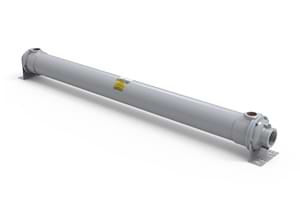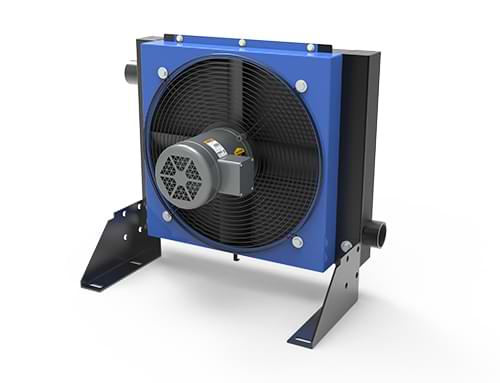Aftercoolers for Polymeric Blasting
These media are generally softer than traditional abrasives like sand or glass beads, making them suitable for delicate surfaces where minimal damage is desired. This method is often used when you need to strip paint or prepare a surface without harming the underlying material.
- Media: Polymeric blasting uses polymer-based media for gentle surface cleaning, stripping, or preparation, likely less damaging than traditional abrasives.
- Applications: Applications include mold cleaning, paint stripping, and aerospace component treatment.
- Importance of Aftercoolers: Aftercoolers are important for operators to ensure dry, cool compressed air, preventing media clumping and equipment damage.
Water Cooled Aftercoolers
Compressor Cooling
- Fixed or Removable Tube Bundles
- Material Options Available
- Standard and Custom Options

Air Cooled Aftercoolers
Compressor Cooling
- Use Ambient Air to Cool
- Variety of Motor Options
- Standard Pressures of Up To 250 psi

Applications of Polymeric Blasting
Polymeric blasting finds use in various industries, offering a gentle yet effective solution for surface treatment:
- Mold Cleaning: It removes mold release agents, debris, and stains from molds in the molding industry without causing damage, helping maintain mold longevity.
- Paint Stripping: It's effective for removing paint from vehicles like cars, trucks, and airplanes, as well as steel and aluminum, without leaving residues.
- Surface Preparation: This method prepares surfaces for new coatings by removing old paint or rust, ensuring better adhesion.
- Deflashing and Deburring: It removes excess material or burrs from manufactured parts, providing a clean finish without additional machining.
- Aerospace Components: It's used for cleaning and stripping coatings from sensitive aerospace parts, preserving their integrity.
Why Aftercoolers Are Important
The success of polymeric blasting hinges on the quality of compressed air propelling the media. Air from typical compressors is hot and laden with moisture, which can condense into liquid water as it cools. This excess moisture causes problems like clumping of polymer particles, reducing flow and blasting effectiveness, making the media overly harsh and risking surface damage, producing uneven results, and rusting equipment over time, leading to frequent repairs and downtime.
How Aftercoolers Enhance Performance
Aftercoolers address these issues by cooling the compressed air after it leaves the compressor, allowing moisture to condense and be filtered out. This ensures dry, consistent airflow, vital for operators because:
- It prevents polymer media from clumping, ensuring smooth and effective blasting.
- It safeguards surfaces by keeping the media’s impact controlled and gentle.
- It boosts efficiency with steady performance, saving time and effort.
- It cuts maintenance costs by protecting equipment from rust and wear.
Interestingly, aftercoolers can also increase blasting speed by up to 15% in humid conditions, a benefit that shines in challenging environments with fluctuating temperatures and humidity, ensuring reliable results.


